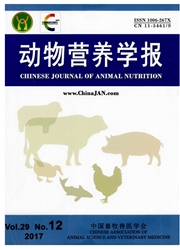

 中文摘要:
中文摘要:
本试验旨在研究淀粉消化性能的差异对生长猪回肠食糜中微生物氮和氨基酸含量的影响。试验采用4×4拉丁方设计,选择4头回肠末端安装有简单T瘘管的杜×长×大三元杂交公猪进行消化代谢试验。结果显示,淀粉来源不同其回肠末端消化率存在差异,在生长猪的回肠末端抗性淀粉有83.07%被消化;糯米淀粉被100%消化,玉米和糙米淀粉介于二者之间,分别有97.63%和96.41%被消化;回肠食糜中氮的流量以采食抗性淀粉日粮组最高(为每千克干物质采食量7.44g),而食糜氮中微生物氮所占比例以采食糯米组最高(为72.8%);各组回肠食糜氨基酸流量中微生物氨基酸所占比率变化范围为25.43%(玉米组)~45.09%(抗性淀粉组),其中抗性淀粉组Asp、Glu、Ser和Lys的比率明显高于玉米组(P〈0.05),但Tyr却低于玉米组(P〈0.05);糙米组Arg显著高于抗性淀粉组,而Ala和Leu却比抗性淀粉组低(P〈0.05);糯米组Ala和Leu也明显较抗性淀粉组低。
 英文摘要:
英文摘要:
The aim of this paper was to investigate the effects of the difference in digestibility of dietary starch on ileal digesta microbial nitrogen and amino acids content of growing pigs. Four duroc ×landrance ×yolkshire cross breed male pigs fitted with permanent simple T cannulation were chosen for the digestibility experiment with 4 ×4 Latin square design. The results indicated that the starch source affected ileal digestibility of starch in growing pig. The ileal digestibility of Resistant starch, stick rice, Corn and brown rice were 83.07%, 100%, 97,63% and 96.41% respectively. Ileal digesta nitrogen flow in resistant starch group was the highest ( 7.44 g per kilogram DMI) among all groups, while the highest percentage of microbial nitrogen in total digesta nitrogen was found in stick rice group (72.8%). Microbial amino acids proportion of ileum digesta of all groups changed in the range of 25.43 % (Corn group) -45.09 % (Resistant starch group), among them the proportion of Asp, Glu, Ser and Lys in Resistant starch group were significant higher than Corn group(P〈0.05), but Tyr was lower than Corn group (P〈0.05). The proportion of Arg in Brown rice group was significant higher than Resistant starch group, while Ala and Leu were lower (P〈0.05). The proportion of Ala and Leu in Stick rice group was also significant lower than Resistant starch group (P〈0. 05).
 同期刊论文项目
同期刊论文项目
 同项目期刊论文
同项目期刊论文
 期刊信息
期刊信息
